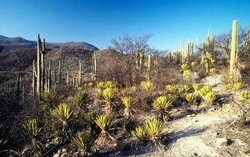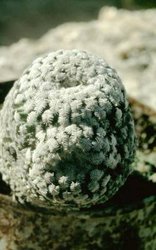Tehuacán Valley matorral
This desert ecoregion is located in central Mexico, and is the center of endemism in the country.
Listed as a center for plant diversity, not only is the number flora species high, but so is fauna species. Bat diversity is extremely high with eighteen endangered, vulnerable, or rare species. Two endemic birds, the ocellated thrasher (Toxostoma ocellatum), bridled sparrow (Aimorphilla mystacalis), and one plant, locally called tetecho (Lemairocereus weberi), inhabit this region.
There are two protected areas of intact habitat; however, agriculture development and cattle ranching threaten much of the remaining region.
Contents
Location and General Description
The region is situated in southeast Puebla and northwestern Oaxaca states, Mexico. It is a portion of the Mixtec-Oaxacan physiographic province, which is formed by Papaloapan River Valley. The Balsas river basin, in the western portion of the region, also has an influence on the area. The region’s limits are the Sierra Madre Oriental, to the north (in the form of an important peak called Sierra de Zongolica) and to the south by the Sierra Norte of Oaxaca, with Sierra de Juárez as the limit.
The region was recognized as a distinctive floristic province by Rzedowski, and it was named as "Floristic Province of Tehuacán-Cuicatlán", because these are the two basins that compose it.
The region is physically isolated from the arid areas of the central plateau by the Trans-volcanic belt province.
The climate is semi-dry hot, with summer rains and slight temperature oscillations. The Sierra de Zongolica and Sierra de Juárez exhibit an orographic shade effect which can affect a range of climatic conditions, and which differentiate it from other Mexican arid environments.
There are a variety of different plant associations that can be recognized for the region. Their presence, development, and abundance depend in part on the soil, climatic and topographic conditions at each particular point throughout the valley. In the Papaloapan basin, the cardon (Lemairocereus weberi) are abundant, as is quiotillo (Escontria chiotilla). The tetecho (Neobuxbaumia tetetzo) have a well-developed lower stratum composed of Mimosa luisana, Prosopis laevigata, Cercidium praecoxs, and Acacia coulteri, among others. Aggregations of Cephalocereus hoppenstedtii can grow up to 10 meters (m) tall and are accompanied by Morkillia luisana, M. mexicana, Castella tortuosa and Echinocactus platyacanthus. At higher elevations in this area (2400-2700 m), scrub of Opuntia macdougaliana, O. huajuapensis and Lemairocereus chichipe grows on soils of volcanic origin. A different type of scrub can be found growing on steep slopes where limestone is more abundant; it is a relatively tall (3-4 m) assemblage of species that can be seen at 2450-2650 m above sea level. Some of the dominant species in this higher altitude scrub are: Lindleyella mespiloides, Wimmeria persicifolia, Cassia chiapensis, Leucaena esculenta, Quercus conspersa & Q. liebmannii. In the Tehuacán valley, an oak scrub can be found; it is composed of short trees (1-3 m), mostly represented by Quercus ceripes and Quercus schenckiana. On the edge of the Salado River, the vegetation is composed by Myrtillocactus geometrizans and Pachycerus hollianus.
Biodiversity Features
The Tehuacán-Cuicatlán valley is an ecological island of extraordinary diversity, and unique assemblages of endemic species. The region is among the richest in plant diversity, with over 2,700 species (Biodiversity), many of which are endemic. Plant endemism is calculated at almost 30% of the total flora. The region is considered as a center for plant diversity for the genera Hechtia, Salvia and some Compositae. It contains four endemic genera of angiosperms: Gypsacanthus, Oaxacania, Pringleochloa and Solisia. At least 50 species of the Asteraceae in the valley are known to be endemic. Of the total species of Mammillaria known to Mexico, 9.86% inhabit this region, and 44% of these are endemic. Of the total species of Mexican columnar cacti, 55% are present in the Tehuacán-Cuicatlán valley, and 30% of these species are endemic.
The region is also considered as a center of origin and diversification of the genus Agave; there are more species of Agave in this desert than anywhere else in the Mexican arid environments. It is known that 75 of the 151 species of Agavaceae in Mexico have a restricted distribution in areas that once served as ecological islands, or refugia. The Tehuacán-Cuicatlán region was one such area. The areas dominated by the Mimosa luisana nurse scrub, contributes to the formation of fertility islands on which nutrients and water can be easily used by Mimosa and other plants. Due to its unique avifauna composition, this region is considered within the Endemic Bird Areas (EBA) of the world proposed by the International Council for Bird Preservation. At least 90 species of birds have been recorded in this region; many of them actively contribute to the dispersion of columnar cacti, and thereby contribute to their known diversity.
Ten of the 90 species of birds are endemic. As a result of the studies of the avifauna of this region, it has been concluded that it has a high diversity, with a third more species than the Sonoran or Chihuahuan desert. The region also has an outstanding diversity of bats, with 34 species. Of these, many species have neotropical affinities, which can be explained in part by the regions closeness to the moist and cloud forests of Veracruz and Oaxaca. Of the 34 species of bats, 18 are endangered, vulnerable, or rare.
Current Status
The region receives federal protection in the form of two areas that contain a considerable portion of well-preserved xeric scrub. However, the main challenge lies in achieving good management programs that take into account the needs of the local villagers and combine them with biological conservation goals.
Types and Severity of Threats
This region is threatened by agricultural and urban expansion. The primary loss of habitat is due to cattle farming and agricultural conversion, two human activities that dramatically alter the local ecological processes. Habitat destruction (Habitat fragmentation) is also caused by construction of dams, road opening, mining and expansion of urban areas. As well, illegal extraction and trade of exotic plant species have lead many cacti to acquire endangered status. Highway construction has already destroyed part of the habitat of Cephalocereus hoppenstedttii, Agave titanota and Fouquieria purpusii. It has been documented that cattle grazing has had a negative impact on the recruitment of young Echinocactus platyacanthus. As a result of urban expansion into arid lands, erosion of the soil and water pollution are severely damaging the native habitat.
Justification of Ecoregion Delineation
This matorral ecoregion is limited to the Tehuacan Valley of southern central Mexico, and is thus isolated from other similar habitats. Deliniations for this ecoregion follow INEGI, from which we lumped the following vegetation classifications: "sarcocaulous matorral", "crasicaulous matorral", and portions of "agricultural landuse".
Reference was also made to Rzedowski, and reviews and revisions to the linework were done by expert opinion at several ecoregional priority setting workshops.
Additional information on this ecoregion
- For a shorter summary of this entry, see the WWF WildWorld profile of this ecoregion.
- To see the species that live in this ecoregion, including images and threat levels, see the WWF Wildfinder description of this ecoregion.
- World Wildlife Fund Homepage
| Disclaimer: This article is taken wholly from, or contains information that was originally published by, the {{{agency}}}. Topic editors and authors for the Encyclopedia of Earth may have edited its content or added new information. The use of information from the {{{agency}}} should not be construed as support for or endorsement by that organization for any new information added by EoE personnel, or for any editing of the original content. |


